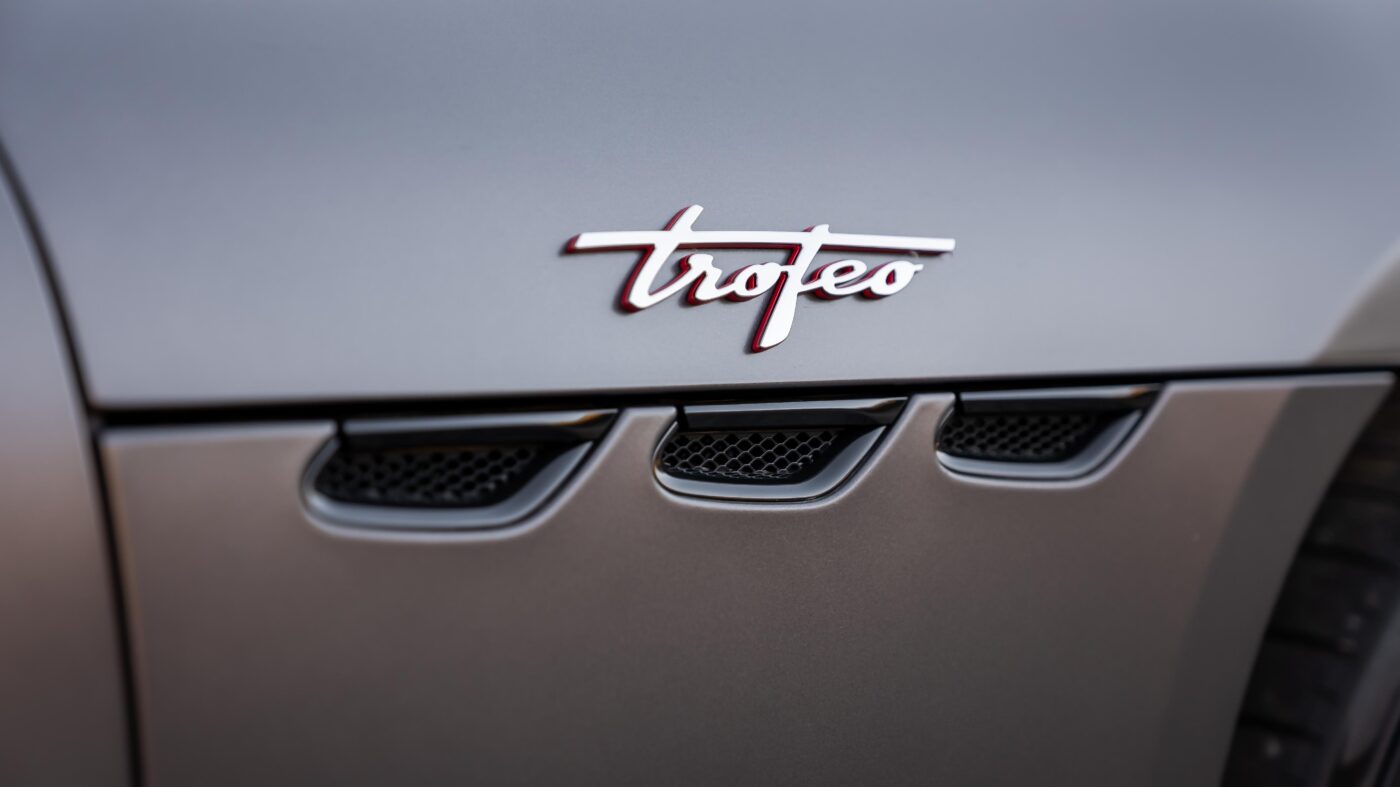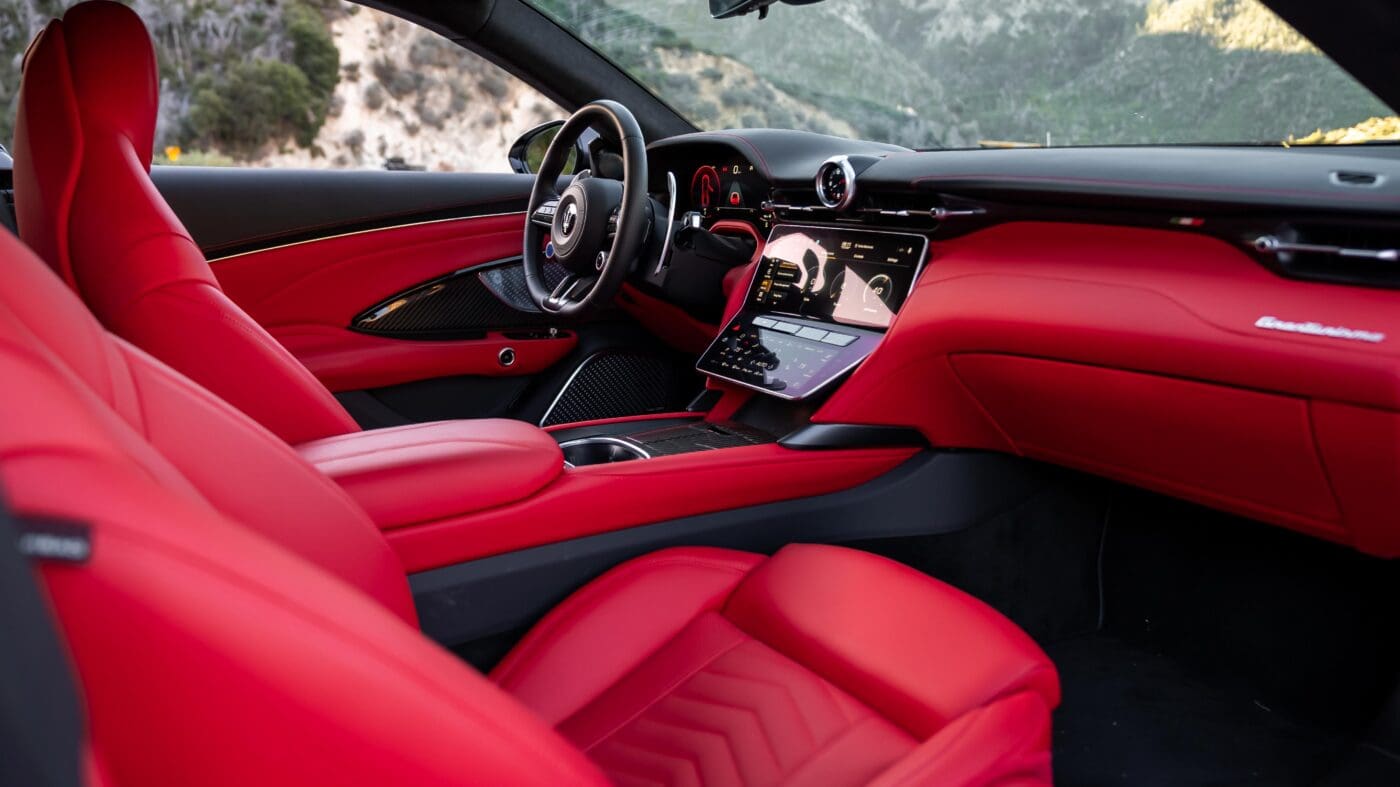Throughout its 108-year run, Maserati has built a reputation as a builder of all types of cars. From racing machines in the 20s and 30s to sedans in the 60s and mid-engined sports cars in the 70s, the Italian carmaker certainly isn’t afraid to step outside its comfort zone. However, no body style is more synonymous with the carmaker’s ethos than the grand tourer.
After all, Maserati’s first road car, the 1946 A6 1500, is a long-hooded, elegant two-door built to cross continents. It would take the marque nearly two decades before it produced anything other than a GT, a streak shattered by the Quattroporte I’s arrival in 1963. As such, the second-gen GranTurismo isn’t just the latest car to join Maserati’s expanding lineup. It’s integral to the brand’s identity.

The 2024 Maserati GranTurismo Trofeo employs a modern twist on a formula that has remained essentially unchanged over seven decades. It combines a lengthy front hood with seats positioned just ahead of its rear axle, oversized windows, and a big rear trunk. However, instead of relying on a throaty, burbly, naturally-aspirated V8 for power, it counts on the brand’s 542 horsepower 3.0-liter twin-turbocharged Nettuno V6.
Couple its healthy output with an all-new Maserati-developed structure, power sent to all four wheels, and active suspension components, and you get a car that isn’t just quick in a straight line but handles far better than a hefty GT ever should. So, while the GT is still primarily a strikingly gorgeous thing worth obsessing over, it no longer sacrifices its backroad athleticism for comfort. It neatly balances these opposing personas, never needing to split the difference to please.

At first glance, you’d be forgiven for confusing the second-gen GranTurismo with its 2007 predecessor. According to Maserati, this familiarity is intentional, citing customer preference for its decision to employ an evolutionary aesthetic. However, while its proportions may resemble the old GT’s, the new car is now 3.4 inches longer and 4.3 inches wider, while its wheelbase shrinks by about half an inch. For context, that’s longer and wider than a Bentley Continental GT.
Despite its larger footprint, the 2024 GranTurismo is only marginally heavier than the car it replaces, tipping the scales at just below 4,000 pounds. This is partly due to the loss of the larger naturally-aspirated V8 in favor of a more compact twin-turbocharged V6. At the same time, its all-new architecture counts on a mix of aluminum, magnesium, and steel to keep the car’s weight down while lowering its center of gravity as much as possible.
The all-electric GranTurismo Folgore, which should hit U.S. shores shortly, kicks that weight figure to the moon thanks to its triple electric motor setup and 92.5-kilowatt-hour battery pack. It lugs around an extra 1,000 pounds, pushing its curb weight figure to a Rolls-Royce-like 4,982 pounds. However, with over 1,200 horsepower on tap, it should be anything but slow.

For now, the GranTurismo is available in two flavors, Modena and Trofeo, with my tester being the latter. Visually, the pair has quite a few differences, with the Trofeo relying heavily on carbon fiber trim, aggressive front and rear fascias, and a staggered wheel set with 20s upfront and 21s in the rear. Its extended bumpers add an extra quarter inch to the car’s length, while curb weight figures remain identical.
Stats aside, what matters most is that the GranTurismo remains strikingly beautiful, a car that brand loyalists and hopefuls alike can lust and obsess over. While we can debate Maserati’s decision to stick with a proven design, it’s hard to argue with its results. The GT is as gorgeous as ever, and even though its footprint rivals that of a Bentley, its proportions allow it to wear its size well, retaining the elegant and stylish aesthetic this grand tourer is known for.
As good as it looks, this large two-door could benefit from a serious drop in ride height. Even in its lowest configuration, the gap between its staggered 20 and 21-inch wheelset and its fenders is highly noticeable. Another half-inch would do wonders for its overall stance.


Under the 2024 Maserati GranTurismo Trofeo’s lengthy hood, you’ll find the carmaker’s now ubiquitous 3.0-liter twin-turbocharged Nettuno V6. It’s the same powerplant that powers the MC20 and the Grecale Trofeo. Although the GT’s configuration is closer to what you get in the crossover than the supercar, thanks to its use of a wet sump over a dry one. It produces 542 horsepower and 479 pound-feet of torque, allowing it to sprint to 62 mph in 3.5 seconds and top out at 199 mph. These performance figures are made possible partly by its all-wheel drive system, a GT first, and a quick-shifting ZF eight-speed automatic transmission.
Maserati’s Nettuno V6 remains as characterful as ever, blending a raspy albeit somewhat quiet exhaust note with two wooshing turbos and plenty of power throughout its rev range. This turbo-six may lag slightly at lower revs, but it delivers consistent power from the mid-range to the redline and, in Sport and Corsa modes, is quite responsive. While the Nettuno isn’t quite as charismatic as its predecessor’s throaty Ferrari co-developed V8, it has a unique persona backed up by formidable performance.
Despite how quick it is on paper, piloting the GranTurismo in most settings is a fairly uneventful affair. Its steering is light, its air springs genuinely plush, and its powertrain subdued in the chiller Comfort and GT drive modes. Only a distant rumble from the exhaust denotes a hit of sportiness. In true grand tourer fashion, it’s the car you can drive daily or on a blast across the country. Improvements to its refinement allow it to slip into the background, almost letting you forget you’re in a nearly 200 mph machine.

Pull up to a back road, click into Sport or Corsa, and the GranTurismo’s personality dramatically shifts. While practically all new cars offer various drive modes, they rarely meaningfully affect that car’s character. No one would expect a big, cozy GT like Maserati’s latest to tackle tight bends the way it does. Its front end has seemingly endless grip and surprising agility for a car as heavy as it is. This is partly possible because the V6’s mounting further back, behind the front axle. And so, despite its lengthy hood, the GT still offers a fairly balanced 52/48 weight distribution.
With its adaptive dampers in their firmest setting, the GT’s body remains nicely controlled, allowing only minimal body roll. Coupled with quick and precise steering, the GranTurismo isn’t just sure-footed in the bends; it’s eager to dive into corners, grip all the way through, and propel you out the other side. While my tester lacked carbon ceramic brakes, it doesn’t need them. The standard steel set is more than apt for back-to-back blasts up an empty back road.
Maserati could’ve pushed the GranTurismo to be slightly more hardcore than it is. There’s still room to firm it up further to make its powertrain’s response more aggressive, but thankfully, the Italian carmaker knew where to stop. The GT sits neatly between a comfortable cruiser like a Bentley Continental GT and a proper sports car like the BMW M8 Competition. Any move in either direction would’ve compromised the other.

The 2024 Maserati GranTurismo doesn’t just improve in the performance aspect, though. Its cabin is massively upgraded over the outgoing car’s. While it may house the same dual-screen infotainment system found in the Grecale, the GT surrounds it with abundant high-quality materials. In my tester’s case, it’s a bright red on red leather interior, which contrasts starkly with its sober Grigio Maratea Matte exterior.
Like the Grecale and the MC20, the GranTurismo provides further evidence that Maserati has worked extensively to improve the build quality of its cars. While its predecessor counted on a pretty basic screen and infotainment system surrounded by a sea of drab plastic buttons, the new car’s layout is sleek, configurable, and easy to operate. That said, the horizontal buttons that shift its gears can be quite cumbersome. They require quite a firm press to activate and can be slow to respond at times.

Maserati goes further than ever with its details, adding more complex stitch patterns to its seats, dashboard, door card designs, and a layered two-tone dashboard that thoughtfully accommodates its multiple screens. Overall, the GT’s cabin represents Maserati’s renewed attention to detail and a level of execution not seen in the brand’s outgoing product era.
These quality improvements arrive as the Italian carmaker pushes itself further upmarket. My 2024 Maserati GranTurismo Trofeo tester, for example, starts at $205,000 but carries an as-tested price of $225,620 thanks to optional extras such as its $4,500 matte paint, $4,000 Sonus Faber sound system, and $2,500 carbon macrotwill interior. And while the GT is vastly superior to the model it replaces, its new elevated price places it within striking distance from cars like the excellent V8-powered Bentley Continental GT, arguably the current grand-touring king.

The second-gen GranTurismo arrives as Maserati is back in a position of strength. While I wasn’t a fan of the cars Maserati put out over the last decade, it’s finally offering a fully refreshed portfolio of genuinely good cars. It started with the MC20 supercar, the Grecale crossover, the GranTurismo, and eventually a Quattroporte replacement. The GT fits nicely not just amongst the brand’s lineup but amongst its closest rivals.
It’s the ideal car for those for whom a BMW M8 Competition is too hardcore while a Bentley Continental GT is too plush. By combining its characterful engine, adaptive suspension, and chassis improvements, Maserati’s latest carves its own lane by delivering sports car performance that doesn’t come at the cost of comfort.
Despite technological advancements and quality improvements, the GT feels distinctly like a Maserati. It is the result of the carmaker’s focus on continuous improvement to leave its past quality issues behind. And as impressive as the GT is, the real question will be whether it’s unique enough to draw buyers away from competitors that established themselves during its absence.











